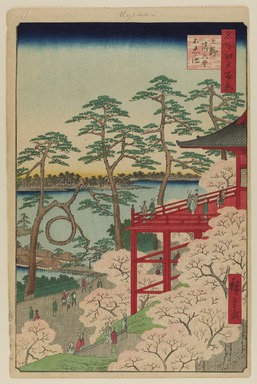
Artist:Utagawa Hiroshige
Medium: Woodblock print
Geograhical Locations:
Dates:4th month of 1856
Dimensions: Image: 13 3/8 x 9 in. (34 x 22.9 cm) Sheet: 14 3/16 x 9 1/4 in. (36 x 23.5 cm)
Collections:
Exhibitions:
Accession Number: 30.1478.11
Image: 30.1478.11_PS20.jpg,
Catalogue Description: Scene shows the Shinobazu Pond in the center of Ueno Park; to the right amidst the cherry blossoms is Kiyomizu Hall, which remains known even today for the splendor of the cherry blossoms. The modern view is diminished by a row of multi-story buildings around the pond, but even in Hiroshige's day, the actual panorama was rather less spectacular than suggested in this print. The veranda extending out from the temple seems improbably wide and the pine trees, which appear in Hiroshige's own Ehon Edo miyage (vol. V) as reaching only up to the level of the veranda, are shown as towering giants. The Kiyomizu Hall was founded in 1631 as part of the ambitious plan of Tenkai - a Tendai priest and one of Tokugawa Ieyasu's chief mentors - to establish a great Buddhist temple complex in Edo which would be comparable in function to that of Enryakuji on Mount Hiei, northeast of Kyoto. The temple was named Toeizan ("Mount Hiei of the East") Kan'eiji (after its founding in 1625, the second year of the Kan'ei era, just an Enryakuji was founded more than eight centuries earlier and named for the Enryaku year period). Like its Kyoto counterpart, Kan'eiji was intended to provide spiritual defense of the city from the northeast, the dangerous direction whence evil spirits came. The Kiyomizu Hall was itself another example of Tenkai's tendency to replicate Kyoto in Edo as a way of bestowing legitimacy on the capital of the shogun. To the left is a small manmade island and here a small temple of Benten, goddess of water, was erected (see pl. 117). The curiously shaped pine at left, with its looped branch, was known as the "Moon Pine" and appears again in plate 89.